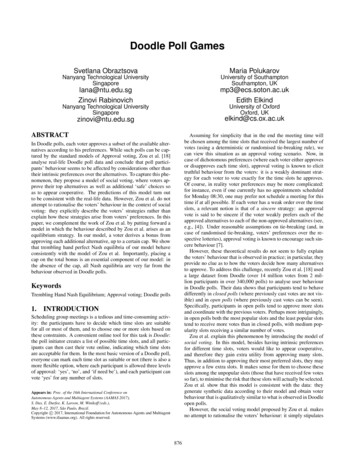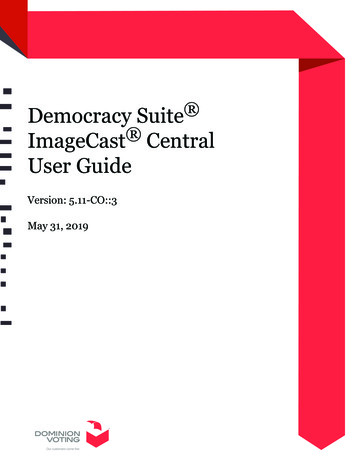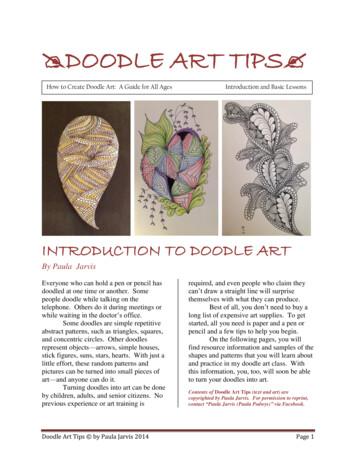
Transcription
Doodle Poll GamesSvetlana ObraztsovaMaria PolukarovNanyang Technological UniversitySingaporeUniversity of SouthamptonSouthampton, UKlana@ntu.edu.sgZinovi Rabinovichmp3@ecs.soton.ac.ukEdith ElkindNanyang Technological UniversitySingaporeUniversity of OxfordOxford, ing for simplicity that in the end the meeting time willbe chosen among the time slots that received the largest number ofvotes (using a deterministic or randomised tie-breaking rule), wecan view this situation as an approval voting scenario. Now, incase of dichotomous preferences (where each voter either approvesor disapproves each time slot), approval voting is known to elicittruthful behaviour from the voters: it is a weakly dominant strategy for each voter to vote exactly for the time slots he approves.Of course, in reality voter preferences may be more complicated:for instance, even if one currently has no appointments scheduledfor Monday 08:30, one may prefer not schedule a meeting for thistime if at all possible. If each voter has a weak order over the timeslots, a relevant notion is that of a sincere strategy: an approvalvote is said to be sincere if the voter weakly prefers each of theapproved alternatives to each of the non-approved alternatives (see,e.g., [4]). Under reasonable assumptions on tie-breaking (and, incase of randomised tie-breaking, voters’ preferences over the respective lotteries), approval voting is known to encourage such sincere behaviour [7].However, these theoretical results do not seem to fully explainthe voters’ behaviour that is observed in practice; in particular, theyprovide no clue as to how the voters decide how many alternativesto approve. To address this challenge, recently Zou et al. [18] useda large dataset from Doodle (over 14 million votes from 2 million participants in over 340,000 polls) to analyse user behaviourin Doodle polls. Their data shows that participants tend to behavedifferently in closed polls (where previously cast votes are not visible) and in open polls (where previously cast votes can be seen).Specifically, participants in open polls tend to approve more slotsand coordinate with the previous voters. Perhaps more intriguingly,in open polls both the most popular slots and the least popular slotstend to receive more votes than in closed polls, with medium popularity slots receiving a similar number of votes.Zou et al. explain this phenomenon by introducing the model ofsocial voting. In this model, besides having intrinsic preferencesfor different time slots, voters would like to appear cooperative,and therefore they gain extra utility from approving many slots.Thus, in addition to approving their most preferred slots, they mayapprove a few extra slots. It makes sense for them to choose theseslots among the unpopular slots (those that have received few votesso far), to minimise the risk that these slots will actually be selected.Zou et al. show that this model is consistent with the data: theygenerate synthetic data according to their model and obtain voterbehaviour that is qualitatively similar to what is observed in Doodleopen polls.However, the social voting model proposed by Zou et al. makesno attempt to rationalise the voters’ behaviour: it simply stipulatesIn Doodle polls, each voter approves a subset of the available alternatives according to his preferences. While such polls can be captured by the standard models of Approval voting, Zou et al. [18]analyse real-life Doodle poll data and conclude that poll participants’ behaviour seems to be affected by considerations other thantheir intrinsic preferences over the alternatives. To capture this phenomenon, they propose a model of social voting, where voters approve their top alternatives as well as additional ‘safe’ choices soas to appear cooperative. The predictions of this model turn outto be consistent with the real-life data. However, Zou et al. do notattempt to rationalise the voters’ behaviour in the context of socialvoting: they explicitly describe the voters’ strategies rather thanexplain how these strategies arise from voters’ preferences. In thispaper, we complement the work of Zou et al. by putting forward amodel in which the behaviour described by Zou et al. arises as anequilibrium strategy. In our model, a voter derives a bonus fromapproving each additional alternative, up to a certain cap. We showthat trembling hand perfect Nash equilibria of our model behaveconsistently with the model of Zou et al. Importantly, placing acap on the total bonus is an essential component of our model: inthe absence of the cap, all Nash equilibria are very far from thebehaviour observed in Doodle polls.KeywordsTrembling Hand Nash Equilibrium; Approval voting; Doodle polls1.INTRODUCTIONScheduling group meetings is a tedious and time-consuming activity: the participants have to decide which time slots are suitablefor all or most of them, and to choose one or more slots based onthese constraints. A convenient online tool for this task is Doodle:the poll initiator creates a list of possible time slots, and all participants can then cast their vote online, indicating which time slotsare acceptable for them. In the most basic version of a Doodle poll,everyone can mark each time slot as suitable or not (there is also amore flexible option, where each participant is allowed three levelsof approval: ‘yes’, ‘no’, and ‘if need be’), and each participant canvote ‘yes’ for any number of slots.Appears in: Proc. of the 16th International Conference onAutonomous Agents and Multiagent Systems (AAMAS 2017),S. Das, E. Durfee, K. Larson, M. Winikoff (eds.),May 8–12, 2017, São Paulo, Brazil.Copyright c 2017, International Foundation for Autonomous Agents and MultiagentSystems (www.ifaamas.org). All rights reserved.876
that each voter will vote for his most preferred slots and some ofhis somewhat less preferred slots based on their popularity; the authors do not reconstruct voters’ utilities that make such behaviourrational. The goal of our work is to fill this gap.In our model, each voter assigns some utility to each time slot(with different utilities corresponding to different preference levels), and the winning alternative is selected among the alternativeswith the highest number of approval points using either a lexicographic tie-breaking rule (based on a fixed ordering of the alternatives) or the randomised tie-breaking rule (where the winner is chosen among the top-scoring alternatives uniformly at random). Weremark that tie-breaking rules play a particularly important role inDoodle polls: since the number of alternatives is often large relativeto the number of votes, ties are quite likely, and, since the decisionsmade by Doodle polls are typically low-stake, both tossing a faircoin and picking the lexicographically first among the top-scoringalternatives is socially acceptable. It remains to explain how votersderive utility from appearing cooperative.A natural first attempt is to assume that, besides deriving therespective utility from the winning slot, each voter obtains a verysmall bonus from each time slot he approves; the second component is supposed to capture his social utility. However, we showthat under these assumptions in each Nash equilibrium (NE) of theresulting game each candidate is approved by almost all voters, and,moreover, if there is no consensus among the voters, the existenceof Nash equilibria requires a very delicate balance of voters’ preferences. Thus, pure Nash equilibria in this model cannot be viewedas realistic predictions of voters’ behaviour.We then consider a more refined version of this approach, wherea voter only gets the social bonus for the first κ time slots that heapproves, for a value of κ that is noticeably smaller than the totalnumber of alternatives. Indeed, it is plausible that, in practice, toappear cooperative, one only needs to approve a number of alternatives that exceeds a certain threshold, and approving further alternatives may not contribute much to the voter’s perception by hispeers. This is corroborated by empirical findings, which demonstrate that voters seem to approve very popular and very unpopular,but not all available slots [18]. This model admits a much richer setof pure Nash equilibria; indeed, we obtain a plethora of ‘bad’ Nashequilibria where everyone approves one alternative (which may beviewed as undesirable by some or even all voters) and κ 1 other alternatives, and approvals are distributed so that every non-winningalternative is far from becoming a winner; a similar phenomenon iswell-known in the context of Plurality voting (see, e.g., [14]).Therefore, it becomes important to come up with a suitable equilibrium refinement that will help us identify Nash equilibria thatare more likely to occur in practice. To do so, we employ a variant of Selten’s celebrated trembling hand perfect Nash equilibrium(THPE) [16, 12]: under this notion, each player assumes that, withsmall probability, other players may make a mistake when implementing their strategy and choose another (random) strategy instead. It has been argued that THPE is the most important refinement of Nash equilibrium [17]; moreover, it is particularly appealing in our setting, where the number of decisions that a voterneeds to make may be large, and mistakes are rarely costly. Trembling hand perfect equilibria have been studied for a wide varietyof games; in particular, in the context of voting, different variantsof THPE have been proposed to explain voter behaviour in plurality and runoff rule voting games [13, 15], information revelationscenarios [11] and agenda-setting games [1].In this work, we modify Selten’s original definition by restricting the type of mistakes that players may make: specifically, weassume that each player makes a mistake independently for eachalternative, i.e., for each alternative he considers, with probabilityε he votes ‘Yes’ if he intends to disapprove this alternative and ‘No’if he intends to approve it, and he votes correctly with probability1 ε. We then show that, in games with capped bonuses, a voter’sbest response to a trembling hand strategy of other players is toapprove all the alternatives at his top preference level as well assome of the most unpopular alternatives, with the total number ofapproved alternatives never exceeding the cap. This result is consistent with the findings of [18]. The analysis of this model is quiteinvolved, and can be seen as our main technical contribution.While our primary goal is to explain voters’ behaviour in Doodle polls, we expect the class of approval voting games with a socialbonus to be of broader interest. Hence, when analysing such games,we do not limit ourselves to the regime that provides the closest approximation to Doodle poll games. In particular, while our primaryfocus is the setting where the social bonus is capped, we also analyse the setting with uncapped social bonus. For the latter settingwe provide efficient algorithms for computing Nash equilibria ifties are broken lexicographically or the voters’ true preferences aredichotomous. We complement these results by showing that, foruncapped social bonus, it is NP-hard to decide if a given preferenceprofile admits a pure strategy Nash equilibrium if ties are broken ina randomised fashion and voters have three or more preference levels. We hope that this analysis will prove useful when consideringother applications of approval voting.From a conceptual perspective, our contribution is twofold. First,while the notion of a social bonus was put forward by [18], we areable to show that this concept can be used to rationalise voters’behaviour. This turns out to be a non-trivial task: the straightforward approach of incorporating the social bonus into the voters’utilities, in an uncapped fashion, results in a model with very fewNash equilibria, which are, moreover, rather unnatural. To overcome this difficulty, we introduce the idea of a cap on the socialbonus, which is both intuitively appealing and enables us to obtainresults that agree with the real-life data. Another innovation is theuse of trembling hand perfection as an equilibrium refinement tool:while this is an elegant and conceptually appealing notion, it hasreceived surprisingly little attention in the algorithmic game theoryliterature; notable exceptions are papers by Hansen, Etessami etal. [10, 8], which, unlike our work, focus on abstract normal-formgames and obtain computational hardness results rather than efficient algorithms, as well as a very recent paper on trembling handequilibria of plurality voting [15], which differs from this work inthat it considers a different voting rule (plurality rather than approval) and no social bonuses.2.PRELIMINARIESThe model we introduce in this paper extends the standard modelof approval voting, so we start by formally defining approval votingand other relevant concepts.In approval voting, there is a set V {v1 , v2 , . . . , v V } of voters, electing a single winner from a set C {c1 , c2 , . . . , c C }of alternatives, or candidates. A single vote (or ballot) of voterv V is a subset of candidates bv C that he approves. We willalso regard bv as a C -dimensional binary vector (bv1 , . . . , bv C )with bvc 1 if v approves alternative c C and bvc 0 otherwise.A voting profile b (bv )v V is a vector of ballots, one for eachvoter.PvGiven a profile b, let sc (b) v V bc denote the score ofcandidate c; the vector s(b) (sc (b))c C is then the score vector of b. The set of (provisional) winners of the election, orthe election outcome, is given by the set of alternatives W (b) arg maxc C sc (b); the ties among the provisional winners are bro-877
ken by a given tie-breaking rule. We consider two common tiebreaking rules: lexicographic, which selects the lexicographicallyfirst candidate in W (b) with respect to a given linear order over C,and randomised, which chooses one uniformly from W (b).Each voter v V has preferences over individual candidates, v , modelled as a total (but not necessarily strict) order on C.That is, v is a reflexive, transitive and complete (but not necessarily anti-symmetric) binary relation on C. We write x v yto express that voter v likes candidate x at least as much as candidate y. We write x v y (strict preference) if x v y but noty v x. Thus, v defines a partition of C into L disjoint subsets{C1v , . . . , CLv }, so that v is indifferent among the alternatives in thesame element of the partition, but strictly prefers any alternative inC v over any alternative in Ckv , for all k. That is, L denotes thenumber of preference levels of the voter. We allow for the possibility that some, but no more than L 2, elements of the partitionare empty. That is, no voter is indifferent between all the alternatives in C, and it is without loss of generality to assume that allvoters have the same number of preference levels L. Specifically,L is the maximum number of proper (i.e., non-empty) preferencelevels across all the voters, and we require that for each voter v thepreference levels 1 and L are not empty. A voter with exactly twoproper preference levels is called dichotomous, and one with threeproper preference levels is called trichotomous.When analysing voters’ strategic behaviour, we need to reasonabout voters’ preferences over election outcomes, i.e., over sets ofprovisional winners. Note that under deterministic tie-breaking,comparing every pair of outcomes is easy: we apply the tie-breakingrule to determine the eventual winner in each set, and comparethese winners using the voter’s preference order v . However, ifties are broken randomly, v does not induce a complete order overall possible outcomes, and a common solution (see, e.g., [5, 2, 9,6, 15]) is to augment voters’ preferences with cardinal utilities. Tothis end, we assume that each voter v is endowed with a functionδv : C Q that takes at most L distinct values and is consistentwith v’s preferences: δv (c) δv (c0 ) if and only if c v c0 . Without loss of generality, we assume that δv (c) 1 if c v c0 for allc0 C and δv (c) 0 if c0 v c for all c0 C. Now, the utilityfrom the outcome, uv (b), of voter v under ballot profile b is defined as follows. If the ties are broken deterministically, accordingto a strict linear order , thendividual alternatives are dichotomous, then he always has a sincerebest response under approval voting, irrespective of how these individual preferences are extended to preferences over outcomes (i.e.,sets)—that is, irrespective of how the utility function of game Γ isdefined [3]. Under some additional assumptions on set preferences,this claim also holds for trichotomous individual preferences, but ifa voter has four or more levels of preference, he may prefer to voteinsincerely. Recently, Endriss [7] has formulated several principlesof lifting individual preferences to set preferences under which avoter will always have a sincere best response in an approval voting game, even if he has more than three proper preference levels.Importantly, the utility functions defined by equations (1) and (2)satisfy these principles.3.MODELDoodle polls can be seen as an implementation of the approval voting rule, which was discussed in the previous section. Specifically,candidates are time slots, and voters indicate their (un)availabilityat these slots. We note that Doodle also allows voters to expresstrichotomous preferences, by classifying the time slots into onesthat are (1) convenient, (2) feasible but inconvenient or (3) not feasible; however, this setting is not captured by the standard model ofapproval voting, so we will not consider it in our work.Our goal is to provide a game-theoretic model that explains theexperimental findings of Zou et al. [18], and in particular the phenomenon of social voting. To this end, we incorporate social rewards into voters’ utility functions. Specifically, we assume thatvoter v gets a social bonus, β, for each of his approved alternatives,as long as their number does not exceed the cap κ, 0 κ C .This cap is the maximum number of approved candidates that is socially rewarded. In approval games, κ 0; if κ C , a voter getsa bonus for each alternative he approves. We assume that socialbonuses never prevail over the original preferences:0 β 1min min δv (c) δv (c0 ) . C v V c,c0 C(3)The total utility of voter v under ballot profile b is then composed of the utility from the outcome uv (b) (given by equation (1)or (2), as per the tie-breaking rule), and the overall social bonus:Uv (b) uv (b) β · min{ bv , κ}.(4)D EFINITION 1. A Doodle poll game (DPG) is a normal-formgame Γ hV, 2C , (Uv )v V i with the set of players V , where foreach player v, his strategy set is the power set of the set of alternatives C and his utility function Uv is defined by equation (4).uv (b) δv (cmax ), where(1)cmax W (b) and cmax c for all c W (b) \ {cmax }.In case of uniform tie-breaking, we consider the expected utility:X1δv (c).(2)uv (b) W (b) 4.UNCAPPED SOCIAL BONUSWe start by providing a few simple observations about the structure of equilibrium profiles in DPGs with uncapped social bonus.We focus on pure strategy Nash equilibria, to which we may refersimply as equilibria or Nash equilibria (NE). Our first observationapplies irrespective of whether there is a cap on the social bonus.c W (b)Assuming that each voter strives to maximise his utility from theoutcome, for a fixed tie-breaking rule our setting induces a normalform game Γ hV, 2C , (uv )v V i where the set of players is givenby the set of voters V , the strategy set available to each player isgiven by the collection of all subsets (i.e., the power set) of the setof candidates C, and the utility function of each player is given byuv as defined by equations (1) or (2) above. We call Γ the approvalvoting game (the tie-breaking rule will be clear from the context).Given voter v’s preference order v , a ballot bv is called sincereif the voter prefers each approved candidate to each disapprovedcandidate; that is, if x v y for all x bv and all y C \ bv [4].Observe that according to this definition, a voter can vote sincerelyin a number of ways, and abstention ballots, in particular, are alsoconsidered sincere. It is known that if a voter’s preferences over in-O BSERVATION 1. For both of our tie-breaking rules, in eachDPG every voter has a best response where he approves all thealternatives at his highest level of preference (and possibly someother alternatives).Indeed, if a voter fails to approve some of his most preferred alternatives, he can only increase his total utility by adding such analternative to his ballot: by doing so he cannot lower his utilityfrom the outcome, while his social bonus may only grow (unlesscapped). In fact, for κ C , every best response is of this form.878
Algorithm 1 NE WINO BSERVATION 2. For both of our tie-breaking rules, in everyequilibrium of a DPG with κ C every voter approves all thealternatives at his highest level of preference.Input: DPG Γ hV, 2C , (Uv )v V i with κ C and tiebreaking order ; candidate w C.Output: YES if there exists an equilibrium with winner w; NOotherwise.When κ C and ties are broken lexicographically, it is beneficialfor everyone to vote for the election winner.answer C TOP TestC TOP (Γ, w)if answer C T OP 6 POSSIBLE thenreturn answer C T OPend ifV 0 : {v V δv (w) 1}answerNonSupporters TestNonSupporters(Γ, w, V 0 )if answerNonSupporters 6 POSSIBLE thenreturn answerNonSupportersend ifreturn TestDisapprovedAllocation(Γ, w, V 0 )O BSERVATION 3. In any equilibrium of a DPG with κ C and lexicographic tie-breaking, all voters approve the (unique) winner of the election.Indeed, if there is a voter that fails to approve the current winner, hewill strictly increase his utility by adding the winner to his ballot:this move will not change the winner—and hence the utility fromthe outcome—for the voter, whereas his social bonus will grow.As for the other candidates, for similar reasons, in an equilibriumprofile they all must get maximum possible support, but so that thecurrent winner remains unchanged.O BSERVATION 4. In any equilibrium of a DPG with κ C and lexicographic tie-breaking, the candidates who are lower thanthe winner in the tie-breaking order are approved by all voters,while those who are higher than the winner in the tie-breaking order are approved by exactly V 1 voters.L EMMA 1. Consider a DPG with lexicographic tie-breakingand κ C . Let b be an equilibrium with winner w. Then forevery voter v with bv C we have δv (w) 1, while for everyvoter v and every candidate c with c v w we have c bv .P ROOF. Let v be a voter that approves all candidates in C andassume that δv (w) 1. Then, there exists another candidate c withδv (c) δv (w). By Observation 3, winner w is approved by all V voters. Let C be the set of all candidates that precede w in the tiebreaking order, and let C be the set of all candidates that appearafter w in the tie-breaking order. By Observation 4, all candidatesin C get V 1 votes and all candidates in C get V votes.Suppose that v changes her vote from C to {c}. If c C , shebecomes the only candidate in C with V points, so she becomesthe unique winner. If c C , then after the change all candidateshave at most V 1 points and all candidates in C \ {c} have V 2 points, so c wins by the tie-breaking rule. Thus, in bothcases c becomes the new winner, so voter v will get a higher utilityfrom the outcome. Moreover, by our assumption about the value ofβ, his total utility will also increase.Suppose now that there exist a voter v and a candidate c suchthat c v w, but c / bv . Clearly, approving c is a profitable movefor v: the outcome either remains the same or changes from w toc, so his utility from the outcome does not go down, and his socialbonus increases by β.A variant of Observations 3 and 4 holds for randomised tie-breaking,in cases where equilibrium profiles result in singleton winner sets.O BSERVATION 5. In a DPG with κ C and randomised tiebreaking, if the winning set for an equilibrium profile has size one,then the unique winner is approved by all voters and every othercandidate is approved by V 1 voters.By combining these observations, we can see that if the socialbonus is uncapped, the structure of the Nash equilibria is very different from what is observed in real-life Doodle polls, as describedby Zou et al. [18]. In particular, in every equilibrium where thewinner set is a singleton, the winner is approved by all voters andall remaining candidates are approved by (almost) all voters.Thus, if we define our goal as to model voters’ behaviour in Doodle polls, we should focus on the setting where the social bonus iscapped, i.e., κ C ; indeed, we consider this case in detail in Section 5 However, the mathematical model of approval voting withuncapped social bonus is of interest per se, as it may be applicableto other approval voting scenarios. Further, the insights obtained byanalysing the simpler case of uncapped social bonus will turn outto be helpful for understanding the more complex scenario wherethe social bonus is capped. Motivated by these considerations, inthe rest of this section we analyse the case κ C in more detail.While most of our results in this section concern the algorithmiccomplexity of computing NE, they also provide useful insights intothe structure of such equilibria: for instance, we leverage Algorithm 1 to show that, for lexicographic tie-breaking, most profilesdo not admit NE.4.1Note that it follows from Lemma 1 that no voter may derive zeroutility from an equilibrium winner. This, in particular, implies thatin games with dichotomous preferences, a candidate can be an equilibrium winner only if she belongs to the top preference level ofeach voter.We are now ready to present a sketch of our algorithm; for implementation details, see the pseudocode (Algorithm 1 and Algorithms 2–4). Assume for convenience that the tie-breaking orderis given by c1 · · · c C .Lexicographic Tie-Breaking First, the algorithm considers the subset of candidates C TOPthat consists of the candidates who are at the top preference level ofevery voter (subroutine TestCTOP ). By Observation 2 and Lemma 1,if C TOP 6 then the election winner belongs to C TOP . Hence,if C TOP 6 , our algorithm checks whether w is the tie-breakingwinner among the candidates in C TOP . If so, it is possible to construct a NE profile where w wins, by letting all voters vote for theirtop choices, and also approve some of their less preferred candidates, so that each candidate gets either V or V 1 votes, depending on her position with respect to w in the tie-breaking order.When ties are broken lexicographically, it is possible to decide inpolynomial time whether there exists a Nash equilibrium (NE) profile where a given alternative wins the election. We denote the corresponding decision problem by NE WIN: NE WIN: Given a DPG with lexicographic tie-breaking and κ C , and an alternative w C, is there a NE with winner w?This problem is solved by Algorithm 1, which relies on subroutines provided by Algorithms 2, 3 and 4. The proof that our algorithm is correct relies on on the following lemma.879
some candidate c0 with c0 c. Indeed, if bv contains all candidatesc0 with c0 c, then v can make c the winner by changing his voteto {c}: after this change, everyone has at most V 1 point, andthe tie-breaking rule favours c over all other candidates. Thus, thealgorithm associates v with the prefix of the tie-breaking order thatends just before c; as argued above, this prefix does not contain w. The algorithm now acts greedily, as follows. It orders the voters in V 0 in the ascending order of the length of the associated prefix of , and considers them in this order. For each i 1, . . . , V 0 ,if ci belongs to the prefix of the i-th voter in this order, the algorithm assigns ci to that voter; otherwise, it returns NO (note thatthis happens only if there are more than i voters in V 0 whose associated prefixes are contained in c1 · · · ci ). When all voters inV 0 have been processed, the algorithm proceeds to its final step. Let C 0 be the set of candidates that precede w in the tiebreaking order and have not been assigned to voters in V 0 in theprevious step. If C 0 , the algorithm returns YES. Otherwise,for each candidate c C 0 the algorithm seeks a voter that will disapprove c in NE (we need one by Observation 4). To this end, thealgorithm checks whether there exists a voter in V that prefers wover c. If such a voter is found for each candidate in C 0 (we canselect the same voter for several candidates in C 0 ), the algorithmreturns YES. Otherwise, it returns NO.Algorithm 2 TestC T OP (first stage of NE WIN)Input: DPG Γ hV, 2C , (Uv )v V i with κ C , tie-breakingorder ; candidate w C.Output: YES if there exists an equilibrium with winner w; NOif it is certain that there is no such NE; POSSIBLE otherwise.C TOP : {c C δv (c) 1 for all v V }if w C TOP thenif w w0 for all w0 C TOP then return YESelse return NOend ifelseif C TOP 6 then return NOend ifend ifreturn POSSIBLEAlgorithm 3 TestNonSupporters (second stage of NE WIN)Input: DPG Γ hV, 2C , (Uv )v V i with κ C , tie-breakingorder ; candidate w C; the set V 0 of voters with δv (w) 1.Output: YES if there exists an equilibrium with winner w; NOif it is certain that there is no such NE; POSSIBLE otherwise.Algorithm 4 TestDisapprovedAllocation (third (main) stage of NE WIN)if V 0 C then return NOend ifif v V 0 such that δv (w) 0 then return NOend ifif v V 0 and c C such that δv (c) δv (w) and w c thenreturn NOend ifreturn POSSIBLEInput: DPG
In Doodle polls, each voter approves a subset of the available alter-natives according to his preferences. While such polls can be cap-tured by the standard models of Approval voting, Zou et al. [18] analyse real-life Doodle poll data and conclude that poll partici-pants' behaviour seems to be affected by considerations other than










